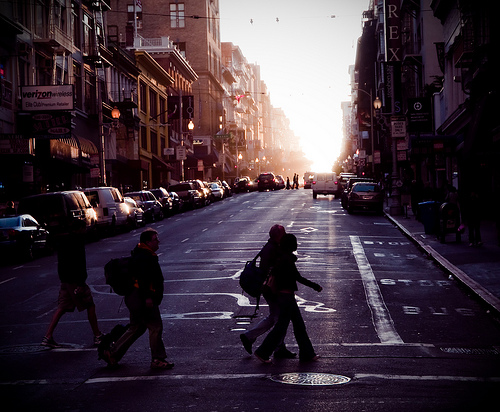Floods, tornadoes and earthquakes are not as dangerous as simply being a pedestrian in America, according to a report by the National Complete Streets Coalition, a nonprofit safety advocacy group. More than 47,000 pedestrians died in vehicle collisions in America over 2003 to 2012, a number which tallies to 16 times the amount of Americans who died in natural disasters.

Cars cause 16 times as many fatalities as natural disasters in the United States. Image from nurpax.
The report, “Dangerous By Design 2014,” was released in conjunction with AARP and the American Society of Landscape Architects, and names the country’s most perilous cities for pedestrians. The top ten include a Southern majority: Orlando, Tampa-St. Petersburg, Jacksonville, Miami, Memphis, Birmingham, Houston, Atlanta, Phoenix and Charlotte.
“We’re at an important time for transportation nationally,” Roger Millar, director of the National Streets Coalition, a program of Smart Growth America, said. “Safety for all users must be a priority in transportation investment.” The study was released as Congress considers a national transportation funding bill.
AARP’s executive vice president for the State and National Group, Nancy LeaMond encouraged Congress to pass the Safe Streets Act, which would guarantee that state and local transport agencies consider all a road’s users when designing and building government-funded roads. “Simply put, the streets in our communities are not working for older Americans,” LeaMond told USA Today.
Even walkable communities must improve safety, states the report, which comprehensively analyzes where the fatalities occur and who is most at risk for every county, metro area and state in the country. The most dangerous areas include communities in the Sunbelt, which rely on “extra wide, fast arterials to connect homes, schools, jobs and shops,” with rare safety considerations for those who dare walk.
The easy-to-navigate online report features data sortable by address and zip code as well as useful state by state comparisons. Additionally, the report’s Pedestrian Danger Index, which takes into account the number of local commuters who walk to work (the best representation of how many people are likely to be walking daily) and five years of recent pedestrian fatality data, gives a chilling depiction of pedestrian deaths, grouped by metro area.
Take Florida, for instance, home to the top four worst cities for pedestrian safety and the worst-ranked state overall. Over 2003 to 2012, 5,189 people were killed while walking in the state, including 960 adults aged 65 or older. Adults age 65 and up comprise nearly 17% of the state’s population, and represent 21.5% of its pedestrian fatalities. Nebraska, on the other hand, was ranked 48th nationally, with just 91 people killed in the state while walking, and 24 adults age 65 or older.
Yet there are commonalities among each of the state’s pedestrian deaths. Arterial roads — which are eligible for federal funds for improvement or construction, under governmental design guidance or oversight — played host to the majority of deaths. “More than half of all pedestrian fatalities occur on arterials, and over 60 percent of these tragedies occur on roads with speed limits of 40 mph or higher,” reads the report. “These roads were not planned or designed for more than speeding traffic.” Usage of these roads has changed, and so must the government’s safety considerations.